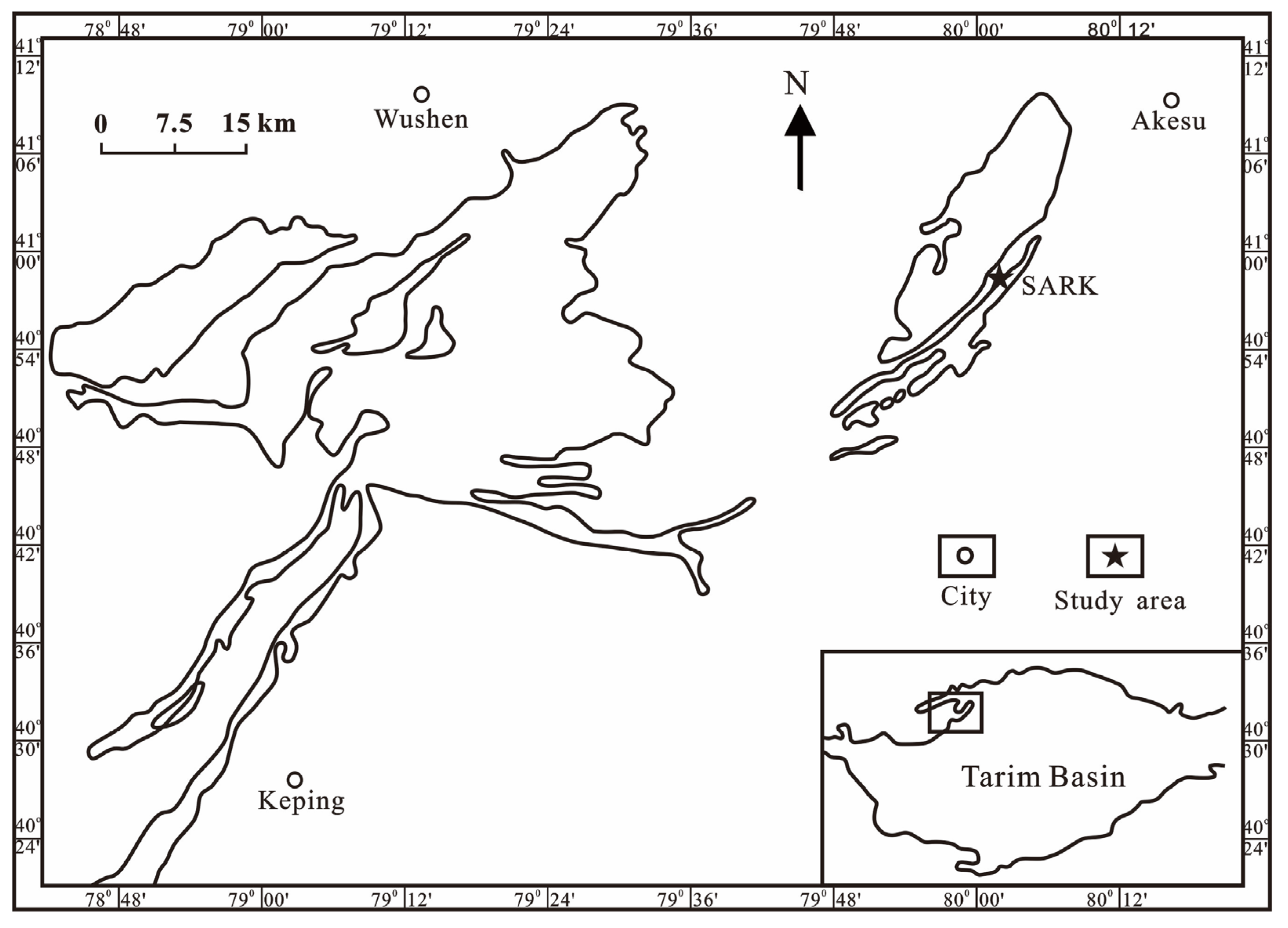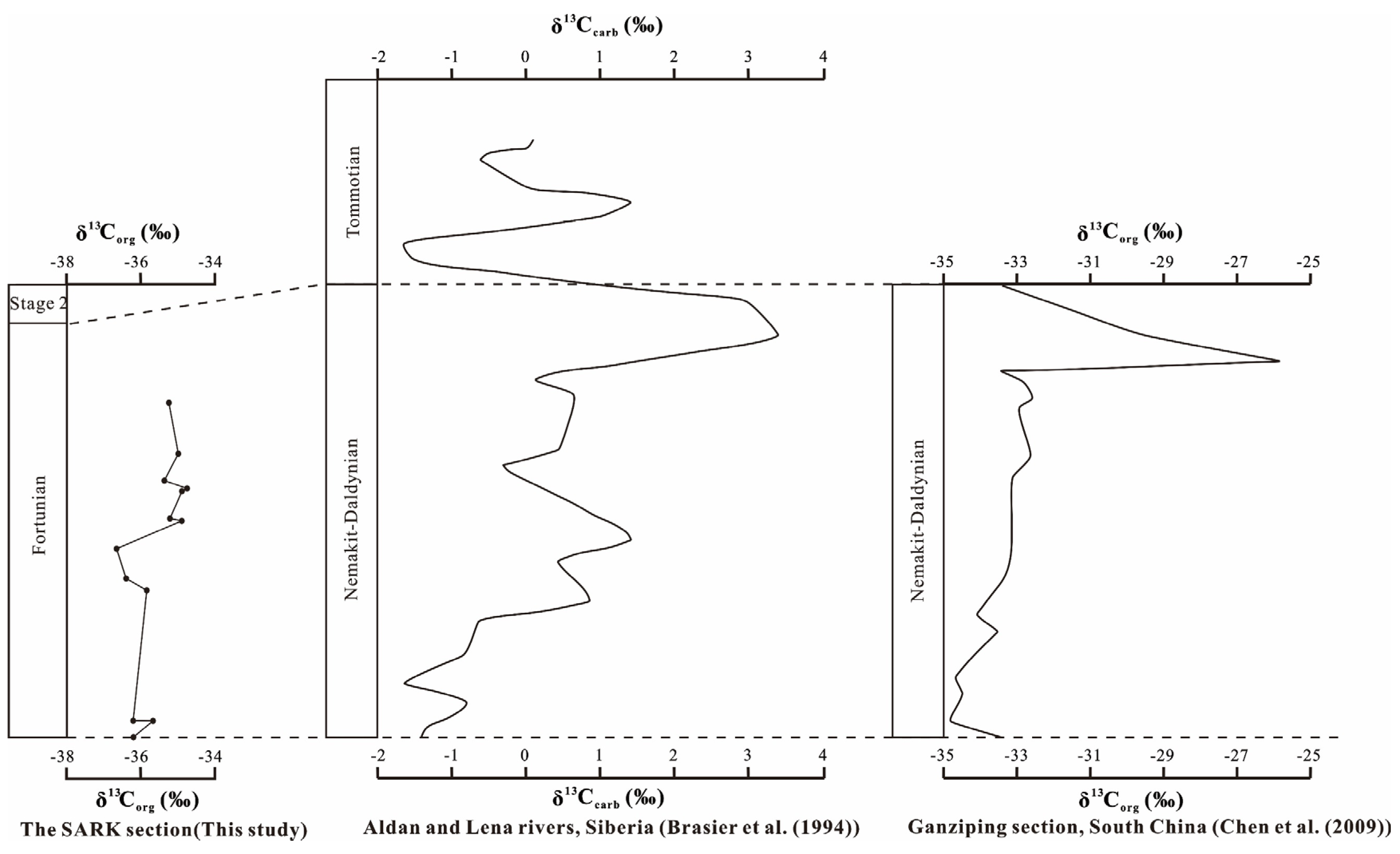Carbon Isotope and Sterane Records of Biological Diversity in the Fortunian Stage of the Early Cambrian Tarim Basin, Northwest China
Abstract
:1. Introduction
2. Geological Settings and Samples
2.1. Geological Settings
2.2. Sample Pre-Treatment and Analytical Methods
3. Results
3.1. Total Organic Carbon and Redox Conditions
3.2. Biomarkers Related to Biological Diversity
3.3. δ13Corg Chemostratigraphy and Its Global Correlation Related to Biological Diversity
4. Discussion
5. Conclusions
Author Contributions
Funding
Data Availability Statement
Conflicts of Interest
References
- Ishikawa, T.; Ueno, Y.; Komiya, T.; Sawaki, Y.; Han, J.; Shu, D.G.; Li, Y.; Maruyama, S.; Yoshida, N. Carbon isotope chemostratigraphy of a Precambrian/Cambrian boundary section in the Three Gorge area, South China: Prominent global-scale isotope excursions just before Cambrian Explosion. Gondwana Res. 2008, 14, 193–208. [Google Scholar] [CrossRef]
- Ishikawa, T.; Ueno, Y.; Shu, D.G.; Li, Y.; Han, J.; Guo, J.F.; Yoshida, N.; Maruyama, S.; Komiya, T. The δ13C excursions spanning the Cambrian explosion to the Canglangpuian mass extinction in the Three Gerges area, South China. Gondwana Res. 2014, 25, 1045–1056. [Google Scholar] [CrossRef]
- Wang, C.J.; Zhao, Y.L.; Peng, J.; Yang, X.L.; Bai, J.; Liu, Y.; Chen, T. Biomarker evidence for biotic and environmental change across the Cambrian Series 2-Series 3 boundary at the Wuliu-Zengjiayan section, Guizhou, China. Sci. China: Earth Sci. 2014, 57, 2781–2790. [Google Scholar] [CrossRef]
- Conway-Morris, S. The Cambrian “explosion”: Slow-fuse or megatonnage? Proc. Natl. Acad. Sci. USA 2000, 97, 4426–4429. [Google Scholar] [CrossRef]
- Li, G.X.; Steiner, M.; Zhu, X.J.; Yang, A.H.; Wang, H.F.; Erdtmann, B.D. Early Cambrian metazoan fossil record of South China: Generic diversity and radiation patterns. Palaeogeogr. Palaeoclimatol. Palaeoecol. 2007, 254, 229–249. [Google Scholar] [CrossRef]
- Shu, D. Cambrian explosion: Birth of tree of animals. Gondwana Res. 2008, 14, 219–240. [Google Scholar] [CrossRef]
- Brasier, M.D.; Corfield, R.M.; Derry, L.A.; Rozanov, A.Y.; Zhuravlev, A.Y. Multiple δ13C excursions spanning the Cambrian explosion to the Botomian crisis in Siberia. Geology 1994, 22, 455–458. [Google Scholar] [CrossRef]
- Guo, J.F.; Li, Y.; Han, J.; Zhang, X.L.; Zhang, Z.F.; Ou, Q.; Liu, J.N.; Shu, D.G.; Maruyama, S.; Komiya, T. Fossil association from the Lower Cambrian Yanjiahe Formation in the Yangtze Gorges Area, Hubei, South China. Acta Geol. Sin.-Engl. Ed. 2008, 82, 1124–1132. [Google Scholar]
- Chen, D.Z.; Wang, J.G.; Qing, H.R.; Yan, D.T.; Li, R.W. Hydrothermal venting activities in the Early Cambrian, South China: Petrological, geochronological and stable isotopic constraints. Chem. Geol. 2009, 258, 168–181. [Google Scholar] [CrossRef]
- Zhou, C.M.; Zhang, J.M.; Li, G.X.; Yu, Z.Y. Carbon and oxygen isotopic record of the Early Cambrian from the Xiaotan section, Yunnan, South China. Sci. Geol. Sin. 1997, 32, 201–211, (In Chinese with English abstract). [Google Scholar]
- Shen, Y.A.; Schidlowski, M. New C isotope stratigraphy from southwest China: Implications for the placement of the Precambrian-Cambrian boundary on the Yangtze Platform and global correlations. Geology 2000, 28, 623–626. [Google Scholar] [CrossRef]
- Brasier, M.D.; Shields, G.; Kuleshov, V.N.; Zhegallo, E.A. Integrated chemo-and biostratigraphic calibration of early animal evolution: Neoproterozoic-early Cambrian of southwest Mongolia. Geol. Mag. 1996, 133, 445–485. [Google Scholar] [CrossRef]
- Yu, B.S.; Dong, H.L.; Widom, E.; Chen, J.Q.; Lin, C.S. Geochemistry of basal Cambrian black shales and cherts from the Northern Tarim Basin, Northwest China: Implications for depositional setting and tectonic history. J. Asian Earth Sci. 2009, 34, 418–436. [Google Scholar] [CrossRef]
- Li, M.J.; Wang, T.G.; Lillis, P.G.; Wang, C.J.; Shi, S.B. The significance of 24-norcholestanes, triaromatic steroids and dinosteroids in oils and Cambrian-Ordovician source rocks from the cratonic region of the Tarim Basin, NW China. Appl. Geochem. 2012, 27, 1643–1654. [Google Scholar] [CrossRef]
- Yao, C.Y.; Ding, H.F.; Ma, D.S.; Li, G.X. Carbon isotope features of the Sugetbrak Section in the Aksu-Wushi Area, Northwest China: Implications for the Precambrian/Cambrian stratigraphic correlations. Acta Geol. Sin. 2014, 88, 1535–1546. [Google Scholar] [CrossRef]
- Zhou, X.Q.; Chen, D.Z.; Dong, S.F.; Zhang, Y.Q.; Guo, Z.H.; Wei, H.Y.; Yu, H. Diagenetic barite deposits in the Yurtus Formation in Tarim Basin, NW China: Implications for barium and sulfur cycling in the earliest Cambrian. Precambr. Res. 2015, 263, 79–87. [Google Scholar] [CrossRef]
- Cai, C.F.; Li, K.K.; Ma, A.L.; Zhang, C.M.; Xu, Z.M.; Worden, R.H.; Wu, G.H.; Zhang, B.S.; Chen, L.X. Distinguishing Cambrian from Upper Ordovician source rocks: Evidence from sulfur isotopes and biomarkers in the Tarim Basin. Org. Geochem. 2009, 40, 755–768. [Google Scholar] [CrossRef]
- He, T.H.; Zeng, Q.H.; Lu, S.F.; Li, W.H.; Li, M.Q.; Wen, Z.G.; Yang, E.Q.; Jing, T.T.; Ying, J.F.; Zhu, P.F.; et al. Aryl isoprenoids from the Lower Paleozoic in the Tarim Basin, NW China: Insight into deep ancient hydrocarbon exploration. Geoenergy Sci. Eng. 2023, 225, 211666. [Google Scholar] [CrossRef]
- Zhu, B.; Yang, T.; Wang, J.; Chen, X.; Pan, W.Q.; Chen, Y.Q. Multiple controls on the paleoenvironment of the early Cambrian black shale-chert in the northwest Tarim Basin, NW China: Trace element, iron speciation and Mo isotopic evidence. Mar. Pet. Geol. 2022, 136, 105434. [Google Scholar] [CrossRef]
- Zhang, C.Y.; Guan, S.W.; Wu, L.; Ren, R.; Wang, L.N.; Wu, X.Q. Depositional environments of early Cambrian marine shale, northwestern Tarim Basin, China: Implications for organic matter accumulation. J. Pet. Sci. Eng. 2020, 194, 107497. [Google Scholar] [CrossRef]
- Zhang, Y.G.; Yang, T.; Hohl, S.V.; Zhu, B.; He, T.C.; Pan, W.Q.; Chen, Y.Q.; Yao, X.Z.; Jiang, S.Y. Seawater carbon and strontium isotope variations through the late Ediacaran to late Cambrian in the Tarim Basin. Precambr. Res. 2020, 345, 105769. [Google Scholar] [CrossRef]
- Zhu, G.Y.; Li, T.T.; Zhao, K.; Li, C.; Cheng, M.; Chen, W.Y.; Yan, H.H.; Zhang, Z.Y.; Algeo, T.J. Mo isotope records from Lower Cambrian black shales, northwestern Tarim Basin (China): Implications for the early Cambrian ocean. Geol. Soc. Am. Bull. 2021, 134, 3–14. [Google Scholar] [CrossRef]
- Grantham, P.J.; Wakefield, L.L. Variations in the sterane carbon number distributions of marine source rock derived crude oils through geological times. Org. Geochem. 1988, 12, 61–77. [Google Scholar] [CrossRef]
- Li, Z.X.; Bogdanova, S.V.; Collins, A.S.; Davidson, A.; De Waele, B.; Ernst, R.E.; Fitzsimons, I.C.W.; Fuck, R.A.; Gladkochub, D.P.; Jacobs, J.; et al. Assembly, configuration, and break-up history of Rodinia: A synthesis. Percambrian Res. 2008, 160, 179–210. [Google Scholar] [CrossRef]
- Zhang, C.L.; Zhou, H.B.; Li, H.K.; Wang, H.Y. Tectonic framework and evolution of the Tarim block in NW China. Gondwana Res. 2013, 23, 1306–1315. [Google Scholar] [CrossRef]
- Zhang, C.L.; Zhou, H.B.; Wang, H.Y.; Li, H.K.; Ye, H.M. Multiple phases of the Neoproterozoic igneous activity in Quruqtagh of the northeastern Tarim Block, NW China: Interaction between plate subduction and mantle plume? Percambrian Res. 2012, 222–223, 488–502. [Google Scholar] [CrossRef]
- Li, Z.X.; Powell, C.M. An outline of the palaeogeographic evolution of the Australasian region since the beginning of the Neoproterozoic. Earth Sci. Rev. 2001, 53, 237–277. [Google Scholar] [CrossRef]
- Turner, S.A. Sedimentary record of Late Neoproterozoic rifting in the NW Tarim Basin, China. Precambr. Res. 2010, 181, 85–96. [Google Scholar] [CrossRef]
- Dong, L.; Xiao, S.H.; Shen, B.; Zhou, C.M.; Li, G.X.; Yao, J.X. Basal Cambrian microfossils from the Yangtze Gorges area (South China) and the Aksu area (Tarim block, northwestern China). J. Paleontol. 2009, 83, 30–44. [Google Scholar] [CrossRef]
- Li, W.H.; Zhang, Z.H.; Li, Y.C.; Fu, N. The effect of river-delta system on the formation of the source rocks in the Baiyun Sag, Pearl River Mouth Basin. Mar. Pet. Geol. 2016, 76, 279–289. [Google Scholar] [CrossRef]
- Zhan, Z.W.; Zou, Y.R.; Shi, J.T.; Sun, J.N.; Peng, P.A. Unmixing of mixed oil using chemometrics. Org. Geochem. 2016, 92, 1–15. [Google Scholar] [CrossRef]
- Joachimski, M.M. Water column anoxia, enhanced productivity and concomitant changes in δ13C and δ34S across the Frasnian-Famennian boundary (Kowala—Holy Cross Mountains/Poland). Chem. Geol. 2001, 175, 109–131. [Google Scholar] [CrossRef]
- Rimmer, S.M.; Thompson, J.A.; Goodnight, S.A.; Robl, T.L. Multiple controls on the preservation of organic matter in Devonian–Mississippian marine black shales: Geochemical and petrographic evidence. Palaeogeogr. Palaeoclimatol. Palaeoecol. 2004, 215, 125–154. [Google Scholar] [CrossRef]
- Zhang, T.G.; Trela, W.; Jiang, S.Y.; Nielsen, J.K.; Shen, Y.A. Major oceanic redox condition change correlated with the rebound of marine animal diversity during the Late Ordovician. Geology 2011, 39, 675–678. [Google Scholar] [CrossRef]
- Brocks, J.J.; Jarrett, A.J.M.; Sirantoine, E.; Kenig, F.; Moczydlowska, M.; Porter, S.; Hope, J. Early sponges and toxic protists: Possible source of cryostane, an age diagnostic biomarker antedating Sturtian Snowball Earth. Geobiology 2016, 14, 129–149. [Google Scholar] [CrossRef] [PubMed]
- Brocks, J.J.; Jarrett, A.J.M.; Sirantoine, E.; Hallmann, C.; Hoshino, Y.; Liyanage, T. The rise of algae in Cryogenian oceans and the emergence of animals. Nature 2017, 548, 578–581. [Google Scholar] [CrossRef]
- Schwark, L.; Empt, P. Sterane biomarkers as indicators of palaeozoic algal evolution and extinction events. Palaeogeogr. Palaeoclimatol. Palaeoecol. 2006, 240, 225–236. [Google Scholar] [CrossRef]
- Jiang, G.Q.; Wang, X.Q.; Shi, X.Y.; Xiao, S.H.; Zhang, S.H.; Dong, J. The origin of decoupled carbonate and organic carbon isotope signatures in the early Cambrian (ca. 542–520Ma) Yangtze platform. Earth Planet. Sci. Lett. 2012, 317–318, 96–110. [Google Scholar] [CrossRef]
- Wang, J.G.; Chen, D.Z.; Yan, D.T.; Wei, H.Y.; Xiang, L. Evolution from an anoxic to oxic deep ocean during the Ediacaran-Cambrian transition and implications for bioradiation. Chem. Geol. 2012, 306–307, 129–138. [Google Scholar] [CrossRef]



| Sample | TOC (%) | V (ppm) | Ni (ppm) | V/(V + Ni) | S/H | C28/C29 | δ13Corg (‰) |
|---|---|---|---|---|---|---|---|
| N1 | 3.37 | 315 | 11.1 | 0.97 | 0.35 | 0.64 | −36.20 |
| N2 | 1.87 | 1026 | 116 | 0.90 | 0.35 | 0.58 | −35.67 |
| N3 | 1.25 | 441 | 40.0 | 0.92 | 0.36 | 0.67 | −36.21 |
| N4 | 1.03 | 391 | 21.4 | 0.95 | 0.39 | 0.95 | −35.84 |
| N5 | 2.65 | 2617 | 25.0 | 0.99 | 0.41 | 0.59 | −36.40 |
| N6 | 0.93 | 249 | 27.9 | 0.90 | 0.37 | 0.46 | −36.67 |
| N7 | 11.00 | 1614 | 913 | 0.64 | 0.47 | 0.65 | −34.92 |
| N8 | 1.61 | 140 | 67.7 | 0.67 | 0.35 | 0.62 | −35.24 |
| N9 | 4.15 | 164 | 19.4 | 0.89 | 0.29 | 0.66 | −34.91 |
| N10 | 8.27 | 903 | 169 | 0.84 | 0.37 | 0.69 | −34.77 |
| N11 | 13.17 | 593 | 57.1 | 0.91 | 0.29 | 0.80 | −35.37 |
| N12 | 10.43 | 421 | 32.1 | 0.93 | 0.38 | 0.67 | −35.01 |
| N13 | 6.55 | 393 | 85.9 | 0.82 | 0.42 | 0.64 | −35.26 |
Disclaimer/Publisher’s Note: The statements, opinions and data contained in all publications are solely those of the individual author(s) and contributor(s) and not of MDPI and/or the editor(s). MDPI and/or the editor(s) disclaim responsibility for any injury to people or property resulting from any ideas, methods, instructions or products referred to in the content. |
© 2025 by the authors. Licensee MDPI, Basel, Switzerland. This article is an open access article distributed under the terms and conditions of the Creative Commons Attribution (CC BY) license (https://creativecommons.org/licenses/by/4.0/).
Share and Cite
Li, W.; Chen, Y.; Wang, L. Carbon Isotope and Sterane Records of Biological Diversity in the Fortunian Stage of the Early Cambrian Tarim Basin, Northwest China. Processes 2025, 13, 1530. https://doi.org/10.3390/pr13051530
Li W, Chen Y, Wang L. Carbon Isotope and Sterane Records of Biological Diversity in the Fortunian Stage of the Early Cambrian Tarim Basin, Northwest China. Processes. 2025; 13(5):1530. https://doi.org/10.3390/pr13051530
Chicago/Turabian StyleLi, Wenhao, Yifan Chen, and Longwei Wang. 2025. "Carbon Isotope and Sterane Records of Biological Diversity in the Fortunian Stage of the Early Cambrian Tarim Basin, Northwest China" Processes 13, no. 5: 1530. https://doi.org/10.3390/pr13051530
APA StyleLi, W., Chen, Y., & Wang, L. (2025). Carbon Isotope and Sterane Records of Biological Diversity in the Fortunian Stage of the Early Cambrian Tarim Basin, Northwest China. Processes, 13(5), 1530. https://doi.org/10.3390/pr13051530








